A 5–50 GHz SiGe BiCMOS Linear Transimpedance Amplifier with 68 dBΩ Differential Gain towards Highly Integrated Quasi-Coherent Receivers
Abstract
:1. Introduction
2. TIA Design
2.1. Input HPF
2.2. TIA Stage
2.3. Post-Amplifier
3. Measurement Results and Discussion
3.1. On-Wafer Characterization
3.2. System Experiments
4. Conclusions
Author Contributions
Funding
Acknowledgments
Conflicts of Interest
References
- Cisco Annual Internet Report (2018–2023) White Paper. 2020. Available online: https://www.cisco.com (accessed on 1 July 2021).
- Houtsma, V.; van Veen, D. Bi-Directional 25G/50G TDM-PON With Extended Power Budget Using 25G APD and Coherent Detection. J. Light. Technol. 2018, 36, 122–127. [Google Scholar] [CrossRef]
- Borkowski, R.; Poehlmann, W.; Brenot, R.; Bonk, R.; Angelini, P.; Caillaud, C.; Achouche, M.; Blache, F.; Goix, M.; Mekhazni, K.; et al. Real-time burst-mode operation of an integrated SOA-PIN/TIA receiver for 25 Gbit/s/λ and faster T(W)DM-PON. In Proceedings of the Optical Fiber Communications Conference and Exhibition (OFC), Los Angeles, CA, USA, 19–23 March 2017; pp. 1–3. [Google Scholar]
- Mecozzi, A.; Antonelli, A.; Shtaif, M. Kramers–Kronig receivers. Adv. Opt. Photon. 2019, 11, 480–517. [Google Scholar] [CrossRef]
- Erkılınc, M.S.; Lavery, D.; Shi, K.; Thomsen, B.C.; Killey, R.I.; Savory, S.J.; Bayvel, P. Comparison of Low Complexity Coherent Receivers for UDWDM-PONs ( λ-to-the-User). J. Light. Technol. 2018, 36, 3453–3464. [Google Scholar] [CrossRef]
- Teixeira, A.; Lavery, D.; Ciaramella, E.; Schmalen, L.; Iiyama, N.; Ferreira, R.M.; Randel, S. DSP Enabled Optical Detection Techniques for PON. J. Light. Technol. 2020, 38, 684–695. [Google Scholar] [CrossRef]
- Rannello, M.; Presi, M.; Ciaramella, E. PBS-Free Polarization-Independent PON Coherent Receiver. IEEE Photonics Technol. Lett. 2020, 32, 1361–1364. [Google Scholar] [CrossRef]
- Jensen, J.B.; Altabas, J.A.; Gallardo, O.; Squartecchia, M.; Valdecasa, G.S. Quasi-coherent Technology for Cost Efficient High Loss Budget Transmission. In Proceedings of the Optical Fiber Communications Conference and Exhibition (OFC), San Diego, CA, USA, 8–12 March 2020; pp. 1–3. [Google Scholar]
- Agrawal, G. Fiber-Optic Communication Systems; Wiley Series in Microwave and Optical Engineering; Wiley: Hoboken, NJ, USA, 2012. [Google Scholar]
- Altabas, J.A.; Valdecasa, G.S.; Suhr, L.F.; Didriksen, M.; Lazaro, J.A.; Garces, I.; Monroy, I.T.; Clausen, A.T.; Jensen, J.B. Real-Time 10 Gbps Polarization Independent Quasicoherent Receiver for NG-PON2 Access Networks. J. Light. Technol. 2019, 37, 651–656. [Google Scholar] [CrossRef] [Green Version]
- Altabas, J.A.; Gallardo, O.; Valdecasa, G.S.; Squartecchia, M.; Johansen, T.K.; Jensen, J.B. DSP-Free Real-Time 25 GBPS Quasicoherent Receiver With Electrical SSB Filtering for C-Band Links up to 40 km SSMF. J. Light. Technol. 2020, 38, 1785–1788. [Google Scholar] [CrossRef]
- Säckinger, E. Analysis and Design of Transimpedance Amplifiers for Optical Receivers; Wiley: Hoboken, NJ, USA, 2017. [Google Scholar]
- Vanisri, T.; Toumazou, C. Integrated high frequency low-noise current-mode optical transimpedance preamplifiers: Theory and practice. IEEE J.-Solid-State Circuits 1995, 30, 677–685. [Google Scholar] [CrossRef]
- Awny, A.; Nagulapalli, R.; Winzer, G.; Kroh, M.; Micusik, D.; Lischke, S.; Knoll, D.; Fischer, G.; Kissinger, D.; Ulusoy, A.C.; et al. A 40 Gb/s Monolithically Integrated Linear Photonic Receiver in a 0.25μm BiCMOS SiGe:C Technology. IEEE Microw. Wirel. Components Lett. 2015, 25, 469–471. [Google Scholar] [CrossRef]
- A wideband monolithically integrated photonic receiver in 0.25-µm SiGe:C BiCMOS technology. In Proceedings of the ESSCIRC Conference 2016: 42nd European Solid-State Circuits Conference, Lausanne, Switzerland, 12–15 September 2016; pp. 487–490. [CrossRef]
- Andrade, H.; Hirokawa, T.; Maharry, A.; Rylyakov, A.; Schow, C.L.; Buckwalter, J.F. Monolithically-Integrated 50 Gbps 2pJ/bit Photoreceiver with Cherry-Hooper TIA in 250 nm BiCMOS Technology. In Proceedings of the Optical Fiber Communications Conference and Exhibition (OFC), San Diego, CA, USA, 3–7 March 2019; pp. 1–3. [Google Scholar]
- García López, I.; Awny, A.; Rito, P.; Ko, M.; Ulusoy, A.C.; Kissinger, D. 100 Gb/s Differential Linear TIAs With Less Than 10 pA/ in 130-nm SiGe:C BiCMOS. IEEE J.-Solid-State Circuits 2018, 53, 458–469. [Google Scholar] [CrossRef]
- Khafaji, M.M.; Belfiore, G.; Ellinger, F. A Linear 65-GHz Bandwidth and 71-dBΩ Gain TIA With 7.2 pA/ in 130-nm SiGe BiCMOS. IEEE-Solid-State Circuits Lett. 2021, 4, 76–79. [Google Scholar] [CrossRef]


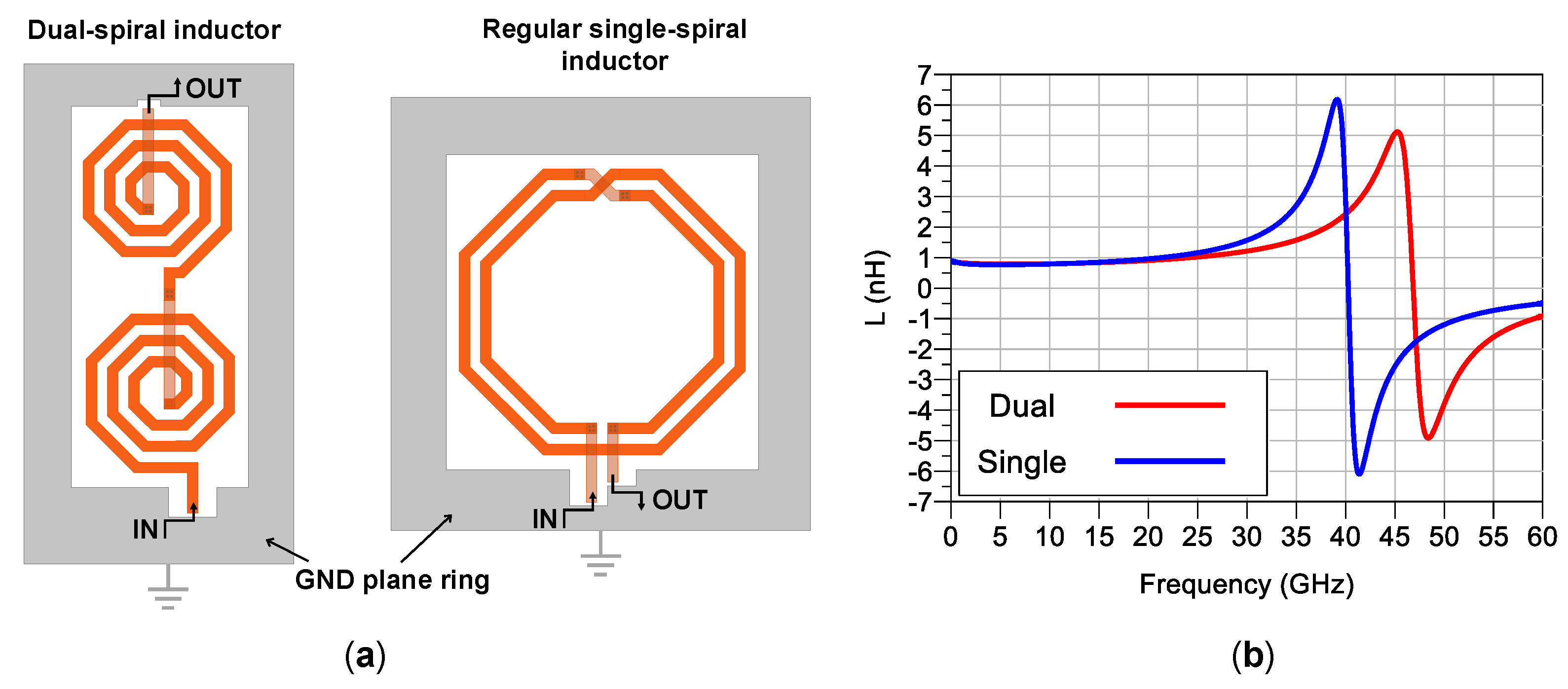
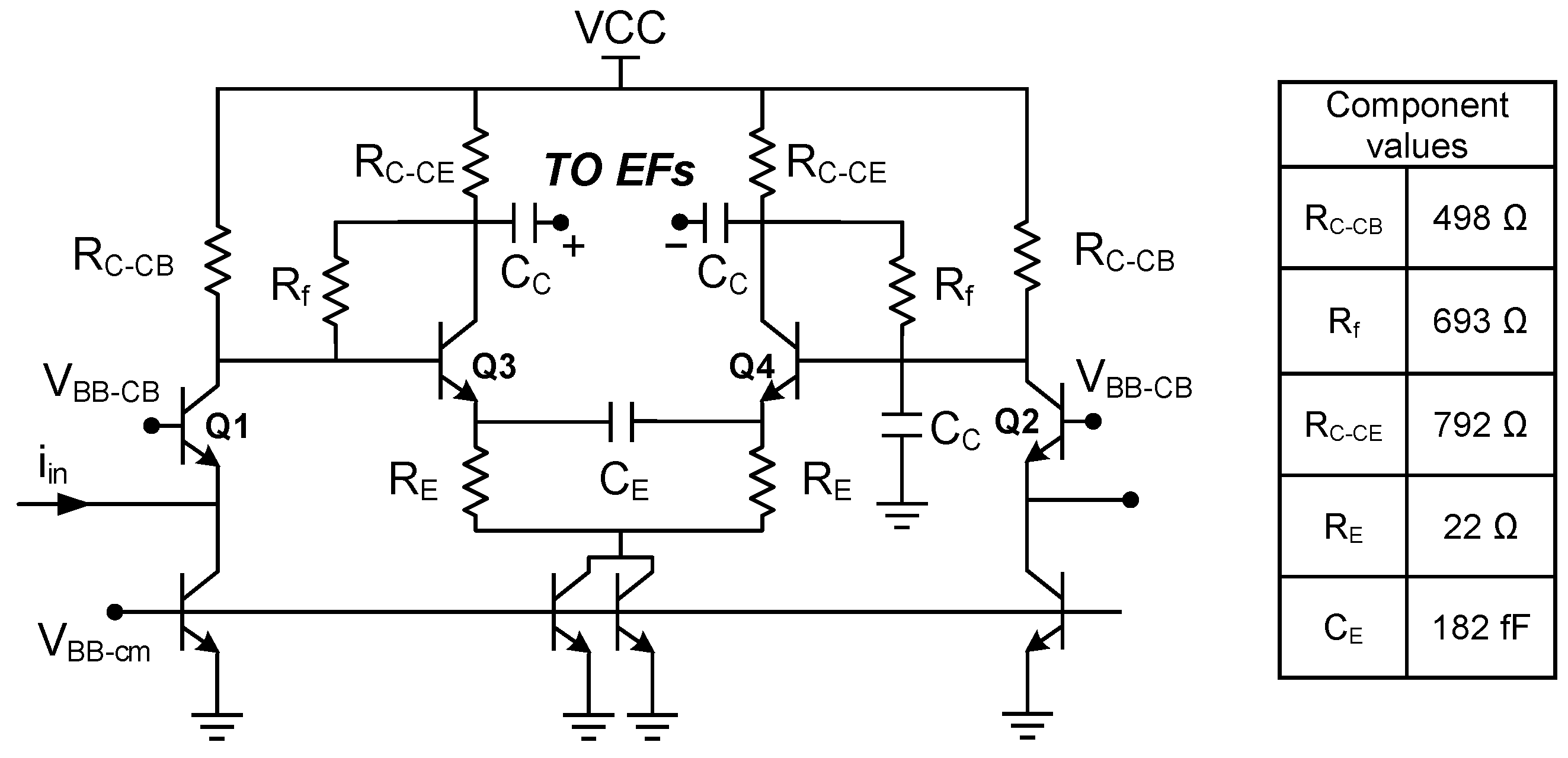
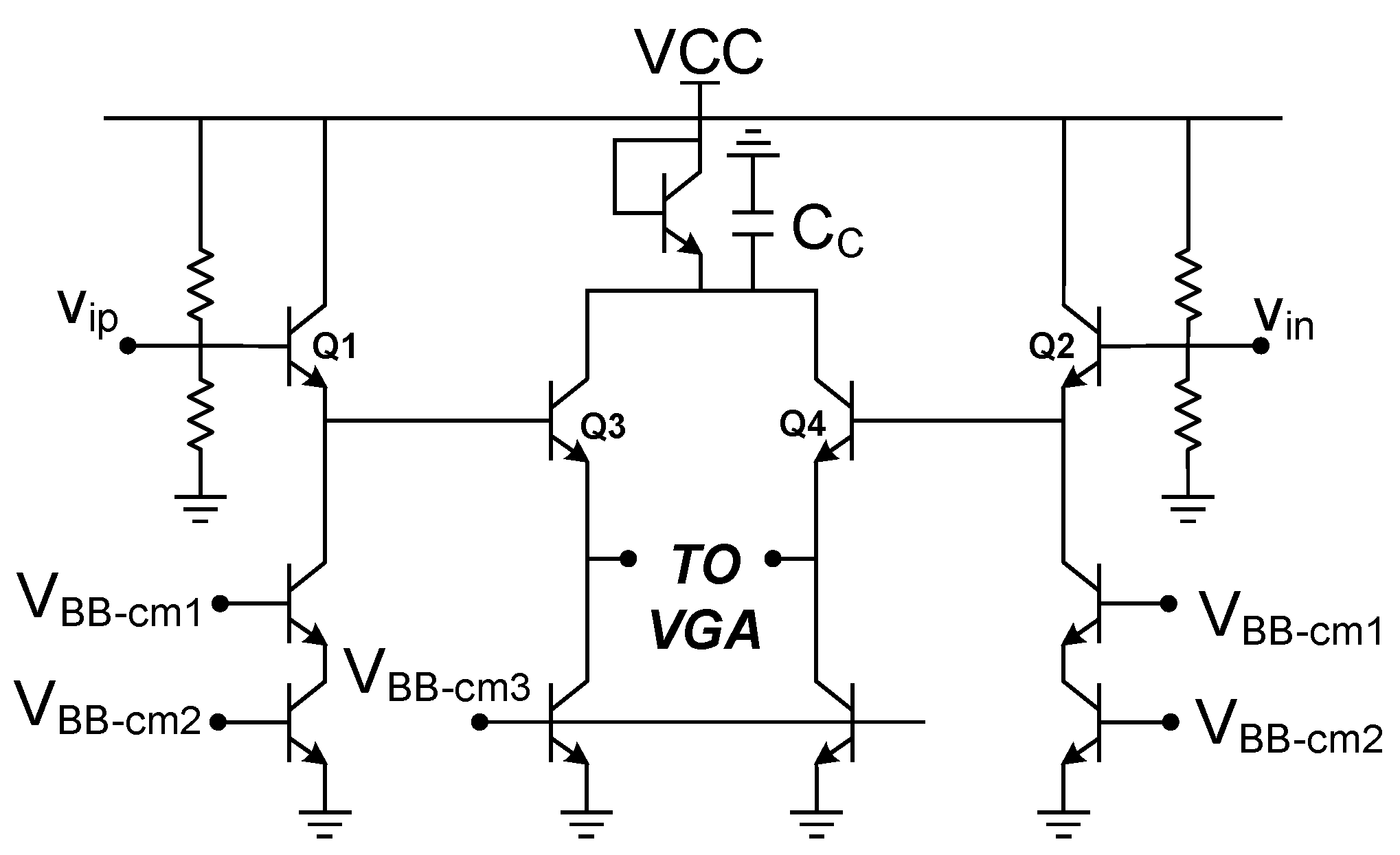

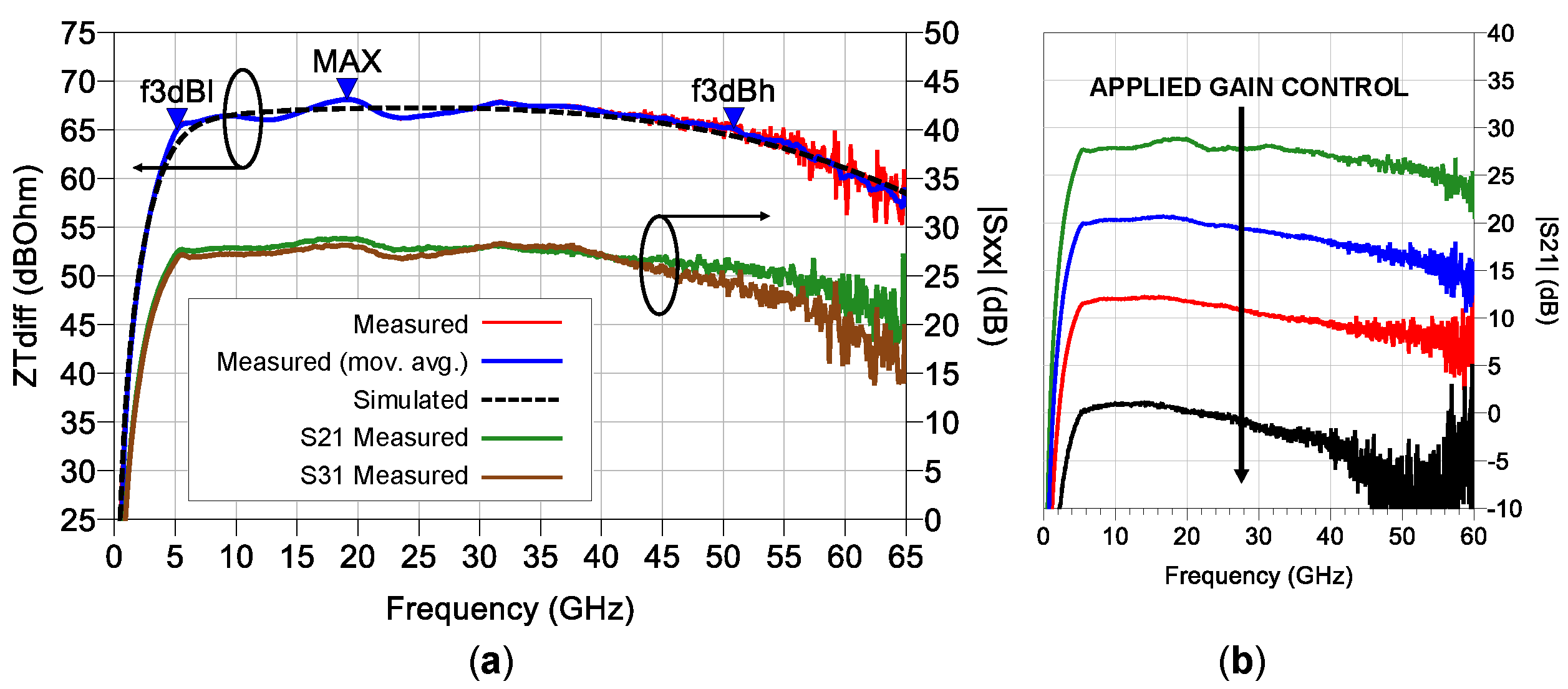

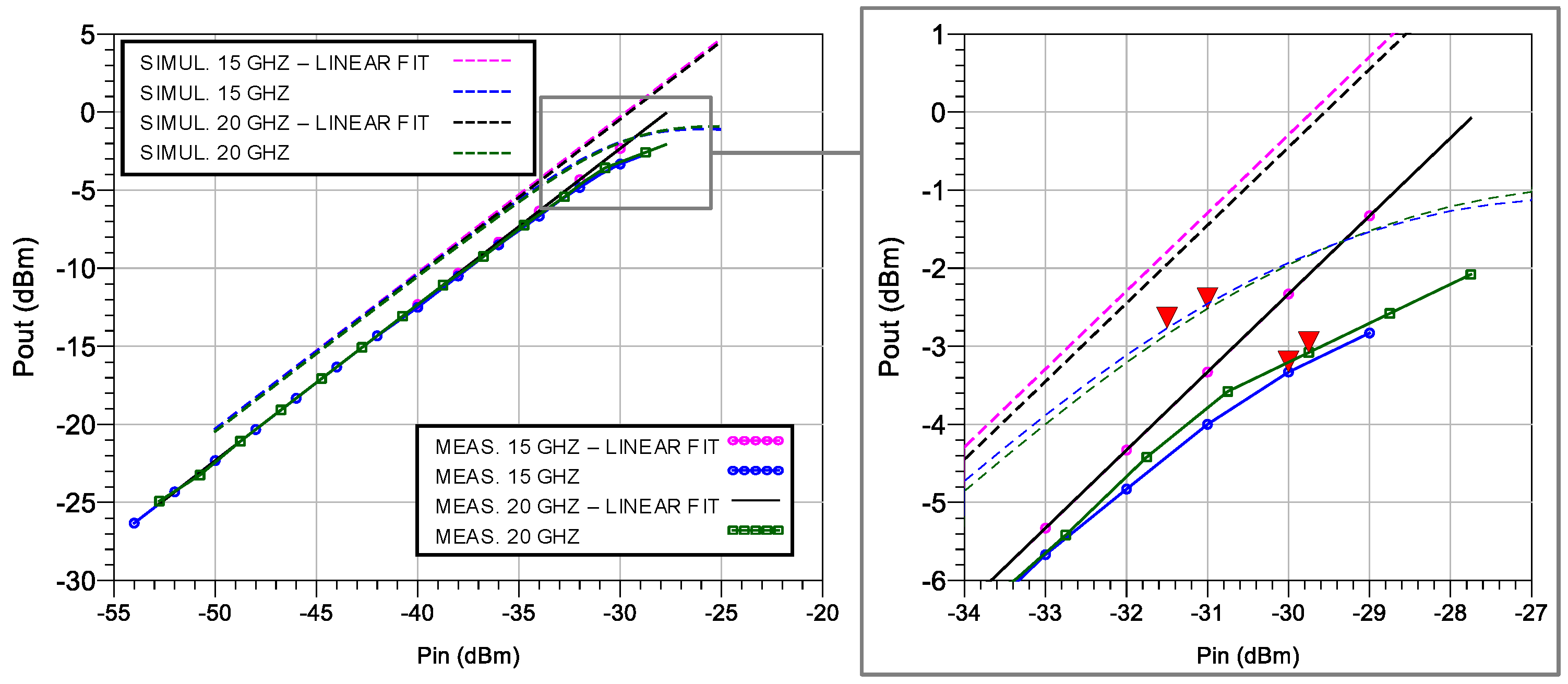


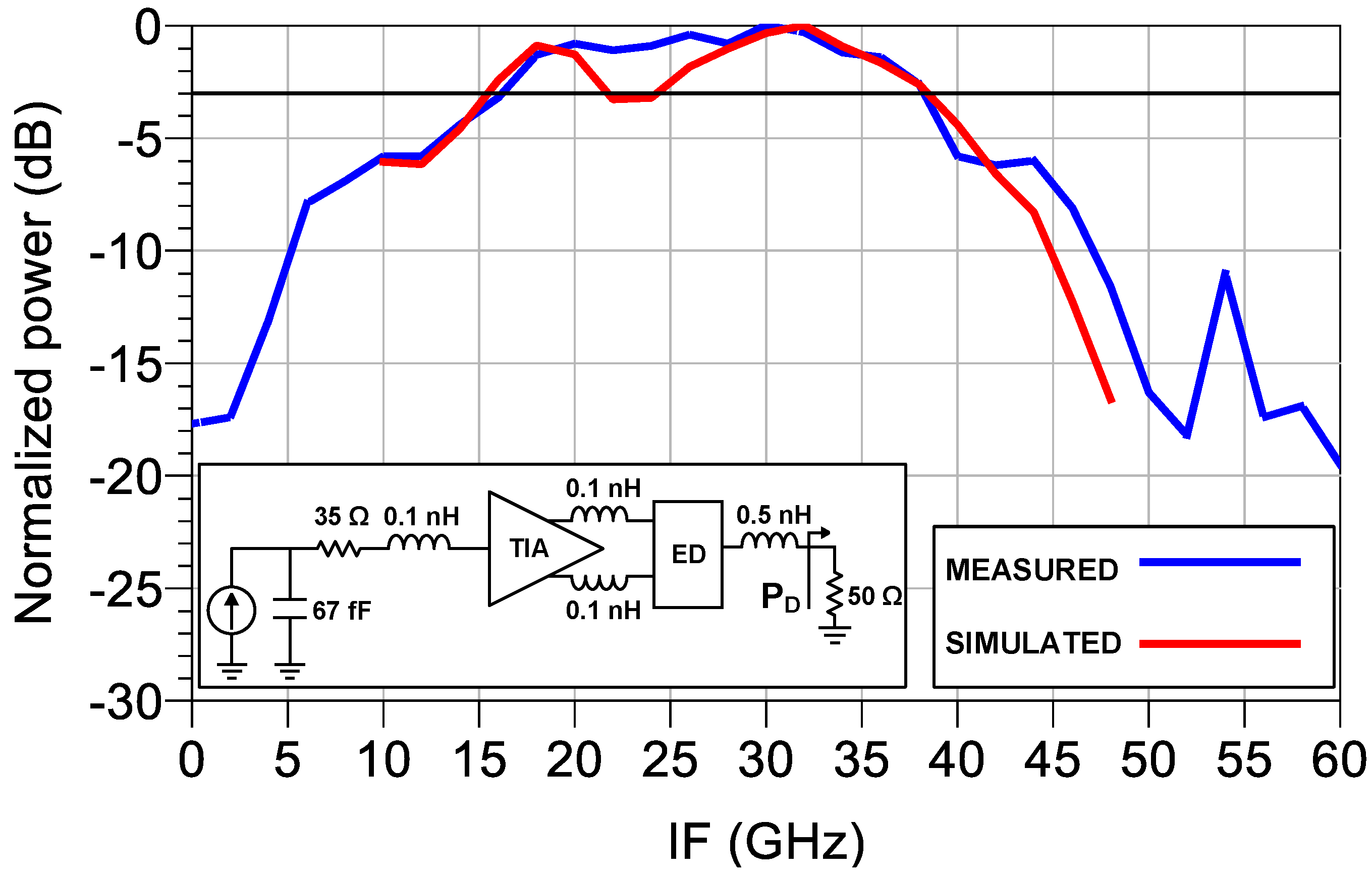
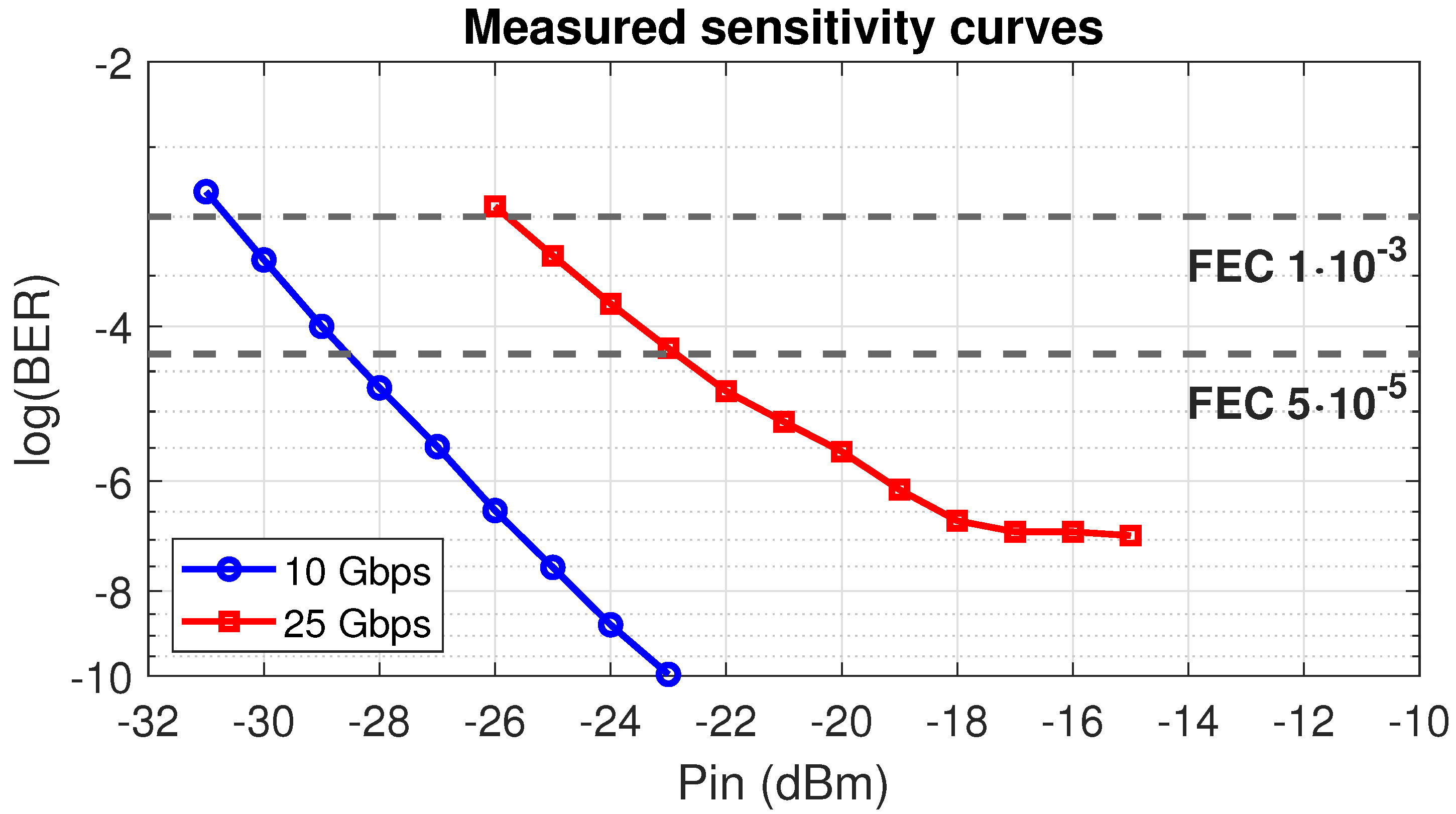
| Ref. | Technology [ft (GHz)] | TIA Topology | BW (GHz) | ZT (dB) | Output Swing (mVpp) | PDC (mW) | RX Sensitivity |
|---|---|---|---|---|---|---|---|
| [14] | 250 nm SiGe BiCMOS [180] | SFB | 31 | 65 | 500 | 275 | −14 dBm (20 Gbps); −10 dBm (40 Gbps) |
| [15] | 250 nm SiGe BiCMOS [N/A] | SFB | 49 | 49 | N/A | 73 | <−7 dBm (40 Gbps); <−3 dBm (54 Gbps) |
| [16] | 250 nm SiGe BiCMOS [N/A] | SFB | 46 | 61 | N/A | 100 | <−16 dBm (25 Gbps) |
| [17] | 130 nm SiGe BiCMOS [250/300] | SFB | 42/66 | 68.5/65 | 800 (@THD < 5%) | 150 | N/A |
| [18] | 130 nm SiGe BiCMOS [300] | SFB | 65 | 71 | 800 (@THD = 1.5%) | 345 | N/A |
| This work | 130 nm SiGe BiCMOS [250] | CB-SFB | 5–50 | 68 | 896 (@1dB compr.) | 228 | −30.5 dBm (10 Gbps); −26 dBm (25 Gbps) |
Publisher’s Note: MDPI stays neutral with regard to jurisdictional claims in published maps and institutional affiliations. |
© 2021 by the authors. Licensee MDPI, Basel, Switzerland. This article is an open access article distributed under the terms and conditions of the Creative Commons Attribution (CC BY) license (https://creativecommons.org/licenses/by/4.0/).
Share and Cite
Silva Valdecasa, G.; Altabas, J.A.; Kupska, M.; Jensen, J.B.; Johansen, T.K. A 5–50 GHz SiGe BiCMOS Linear Transimpedance Amplifier with 68 dBΩ Differential Gain towards Highly Integrated Quasi-Coherent Receivers. Electronics 2021, 10, 2349. https://doi.org/10.3390/electronics10192349
Silva Valdecasa G, Altabas JA, Kupska M, Jensen JB, Johansen TK. A 5–50 GHz SiGe BiCMOS Linear Transimpedance Amplifier with 68 dBΩ Differential Gain towards Highly Integrated Quasi-Coherent Receivers. Electronics. 2021; 10(19):2349. https://doi.org/10.3390/electronics10192349
Chicago/Turabian StyleSilva Valdecasa, Guillermo, Jose A. Altabas, Monika Kupska, Jesper Bevensee Jensen, and Tom K. Johansen. 2021. "A 5–50 GHz SiGe BiCMOS Linear Transimpedance Amplifier with 68 dBΩ Differential Gain towards Highly Integrated Quasi-Coherent Receivers" Electronics 10, no. 19: 2349. https://doi.org/10.3390/electronics10192349
APA StyleSilva Valdecasa, G., Altabas, J. A., Kupska, M., Jensen, J. B., & Johansen, T. K. (2021). A 5–50 GHz SiGe BiCMOS Linear Transimpedance Amplifier with 68 dBΩ Differential Gain towards Highly Integrated Quasi-Coherent Receivers. Electronics, 10(19), 2349. https://doi.org/10.3390/electronics10192349






